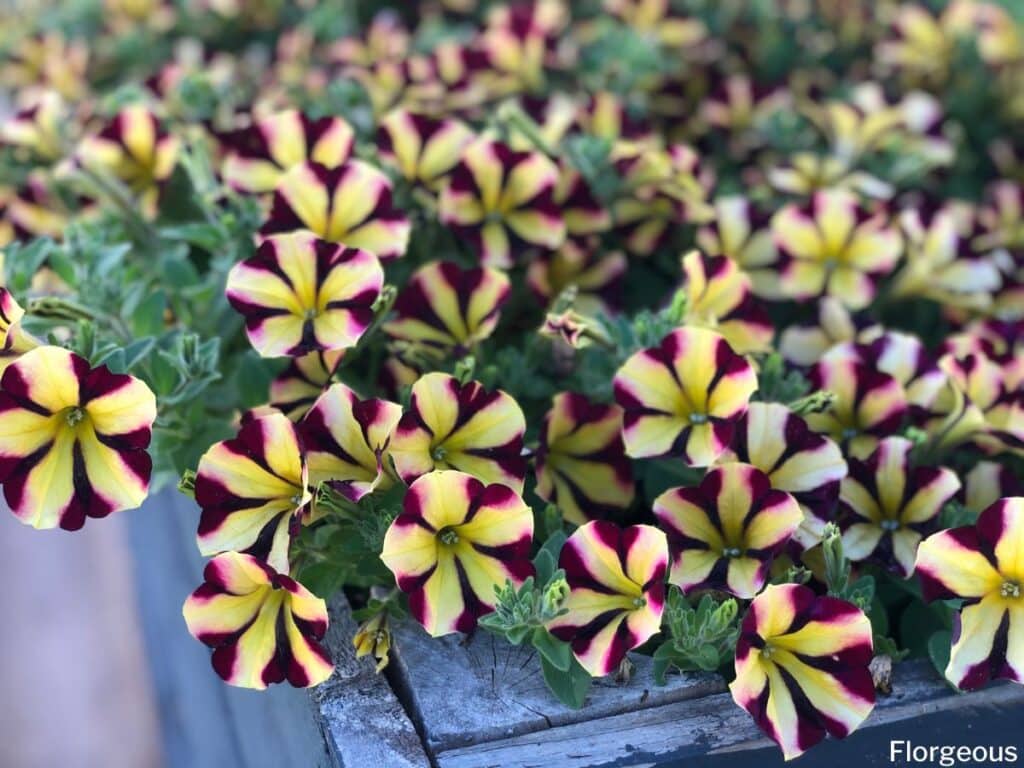Petunias (Petunia x atkinsiana) are cheerful flowering plants that can add lots of color and aesthetic charm to your garden. A lot of gardeners absolutely adore these flowers because they are so hardy and easy to grow.
Thanks to their hardy nature, these plants have many garden applications. You can plant petunias directly in garden beds, place them in hanging baskets, grow them in containers, use them as garden fillers, or grow them in masses to create striking borders.
While petunias offer plenty of charm all on their own, they look even better when you pair them with other plants that can enhance their beauty. Companion planting with petunia flowers can also offer added benefits to your garden because these colorful flowers help attract pollinators and other beneficial insects to your garden.
In this guide, we are going to take a quick look at some of the best petunia companion plants to add to your garden if you want to grow a vigorous and vibrant garden.
What to Plant with Petunias
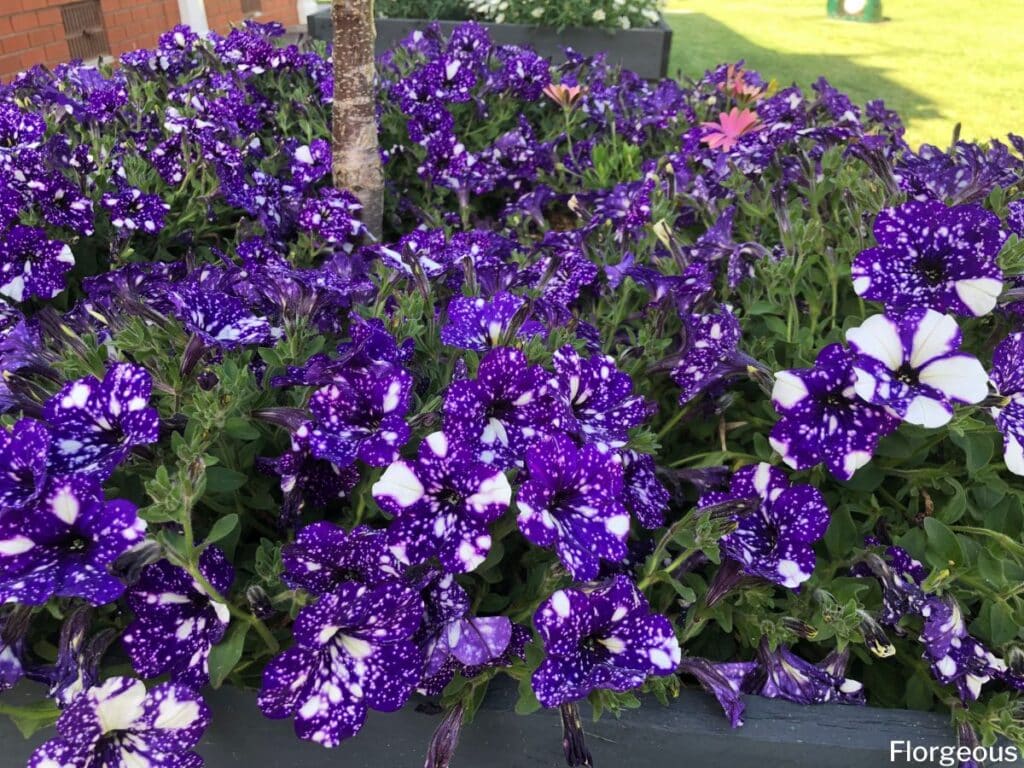
Currently, there are 35 known species of petunias and these different species vary in color. They can produce beautiful blooms in pink, cherry, red, blue, yellow, lime green, magenta, or orange and there are also some mixed varieties.
These vivid flowers can look striking next to a huge variety of plant species but not all plants can survive in the harsh conditions that petunias thrive in.
When you are selecting companion plants for petunias, it is always best to select varieties that have similar growing conditions.
Petunias need full sun or they won’t produce any blooms and their growth can also be stunted if they are grown in partial shade. These plants also flourish under drier, almost drought, conditions. They should be established in well-draining soil in hardiness zones 9 – 11 or they will quickly develop root rot.
Now that we know more about this plant’s growing needs, it is time to take a look at other plants that can also tolerate these hot, dry, and sunny conditions.
Blueberry Bushes
Blueberries (Vaccinium angustifolium) are great companions to grow when you are planting petunias. Petunias will do a fantastic job at attracting pollinators that can increase your blueberry yields. They will also lure carnivorous insects to your garden that can help fight common blueberry pests.
The blueberry bush and fruits will also complement the vivid colors of pink, red, or purple petunias very well when they are growing right next to each other.
As with petunias, blueberries need full sun and well-drained soil. This plant also likes consistent watering and prefers nutrient-rich soil that is covered in a layer of mulch.
Because blueberries are taller with some varieties reaching up to 4 meters high, you should position them in the back with the shorter petunias as a border plant in the front of your garden beds.
Creeping Jenny
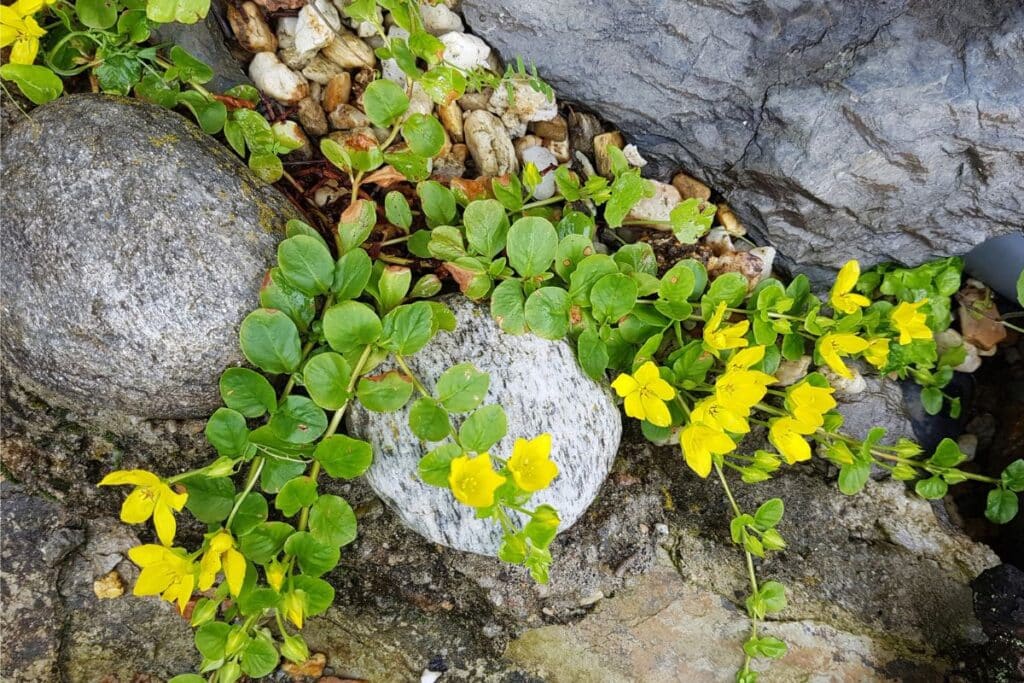
Creeping jenny (Lysimachia nummularia), also known as moneywort, is a popular trailing plant that can look striking if you pair them in containers with petunia plants. The creeping jenny will create a stunning look as a spiller that flows over the edge of the container with vibrant petunias as a filler plant in the hanging baskets.
These vine plants will thrive in the semi-shade created by the taller petunias but also grow well in full sun. Unlike petunias, these hanging basket flowers prefer moist soil, so you will need to take care to add a little bit more water to these companion plants.
Creeping jennies can also be useful ground covers to keep the soil moist and cool around peonies. They will stay low to the ground with a height of just 4 inches tall so you can easily establish them all over the garden beds underneath your peonies.
Dusty Miller
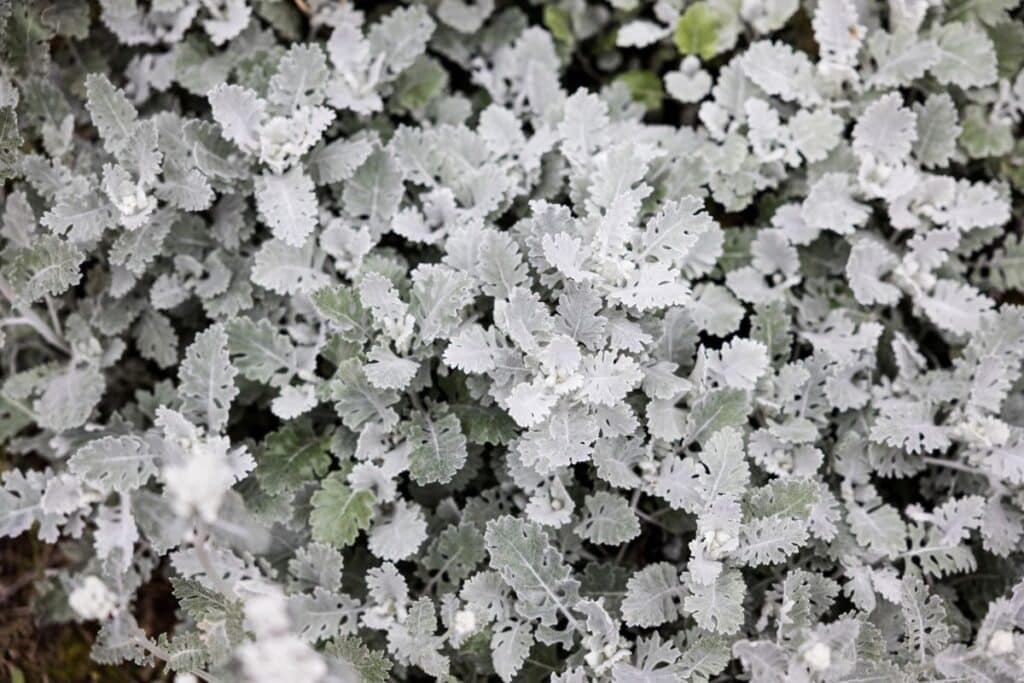
Dusty miller (Senecio cineraria) is an excellent companion plant to grow with petunias if you want to create lots of contrast in your garden bed. The silvery grey foliage of this plant will create a great contrast with the bright blooms of peonies and this plant is useful as a border or garden filler. Dusty miller companion plants include ornamental grasses, begonias, salvias, and many others.
Dusty miller flourishes in direct sunlight and well-draining soil. The shrub prefers moderately rich soil but can also grow in poor soil conditions. The silver-tinted foliage does need a little bit more water than petunias and performs best in moist soil but it can survive in relatively dry conditions.
These bushy plants will only grow up to 18 inches tall and you should be careful not to plant them too close to petunias. The silvery leaves will lose their vibrant color if they don’t receive enough direct sunlight. It is best to establish them as a border besides your slightly taller petunias.
Society Garlic
Society garlic (Tulbaghia violacea) is an excellent variety to consider if you want to create a low-maintenance garden. This low-maintenance plant is just as hardy and drought-tolerant as petunias and is ideal for rocky garden beds or xeriscape projects.
Their tall grass-like leaves will also add lots of texture to your garden and the small purple flowers will look rather striking if you pair them with purple petunias.
Society garlic prefers light and sandy soil that drains very well and they need to be established in direct sunlight. They only require occasional watering but will survive next to the slightly more water-reliant petunias.
This fragrant plant can be used as a border to protect your petunias from common pests but you can also grow it amongst the petunias because the flowers will look beautiful as they peek out amongst the petunias.
Red Salvia
Red salvia (Salvia coccinea), also known as blood sage, scarlet sage, Texas sage, or tropical sage can be wonderful companion plants for warm tinted flowers like red petunias. These flowering plants produce vivid red flowers on tall spikes and will add lots of color and texture to your flower beds.
Planting red salvia in direct sunlight will enhance their rich red color but they can also grow in dappled shade. These plants should be established in fertile well-draining soil but they need more frequent watering than petunias, especially in warm weather.
The foliage of these plants has a similar height as petunias but when they bloom, the tall flowers on spikes can grow up to 30 inches tall. It is best to add these flowering plants in the back of your garden but you can also grow them amongst petunias because the tall red spikes can look charming as they poke out amongst mass-planted petunias.
Tomatoes
Petunias are often included in a vegetable garden because they attract pollinators that can increase vegetable yields. They are terrific tomato (Solanum lycopersicum) companions because they attract carnivorous insects that feed on common tomato pests like aphids and the beautiful petunias will enhance the overall look of your vegetable gardens.
Tomatoes require plenty of direct sun to produce juicy fruits. They also grow well in good draining soil and need regular watering but not too much to cause root rot in petunias.
Because tomatoes tend to be a little bit taller, it is usually best to place them in the back and to grow petunias around the base of the tomatoes in the front where they can act as a ground cover to keep the soil moist.
Snapdragons
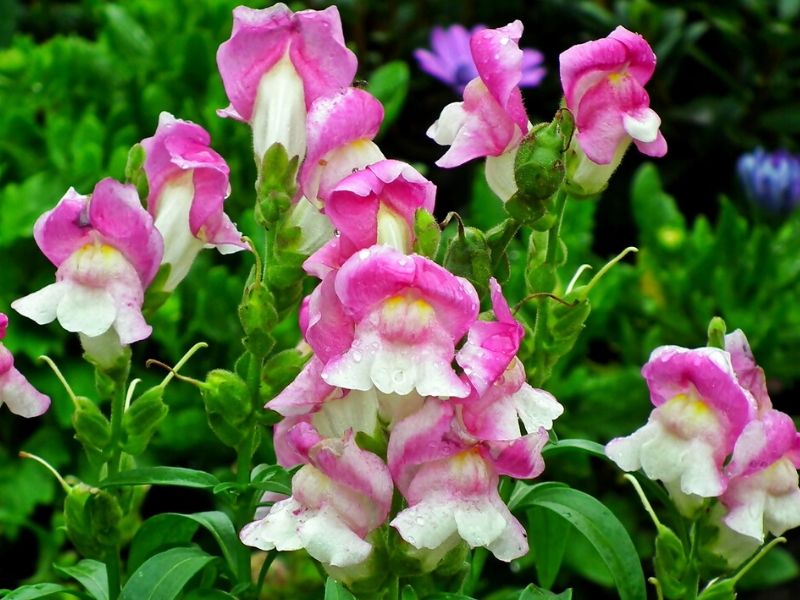
Snapdragons (Anthirrhinum) with their unique blooms and vivid colors are wonderful for perking up a flower bed and will grow well next to petunias. These plants produce bright flowers on towers in colors like yellow, white, purple, pink, and red when they flower from spring to fall.
The short-lived perennials grow well in well-draining soil and direct sun but they can also tolerate dappled shade. Once established, these flowering plants will only need about 1 inch of water per week and perhaps a little more in hot periods.
The showy blooms will only grow up to 15 inches long which means they are ideal for co-planting or mixing with petunias in the same garden bed.
What NOT to Plant with Petunias
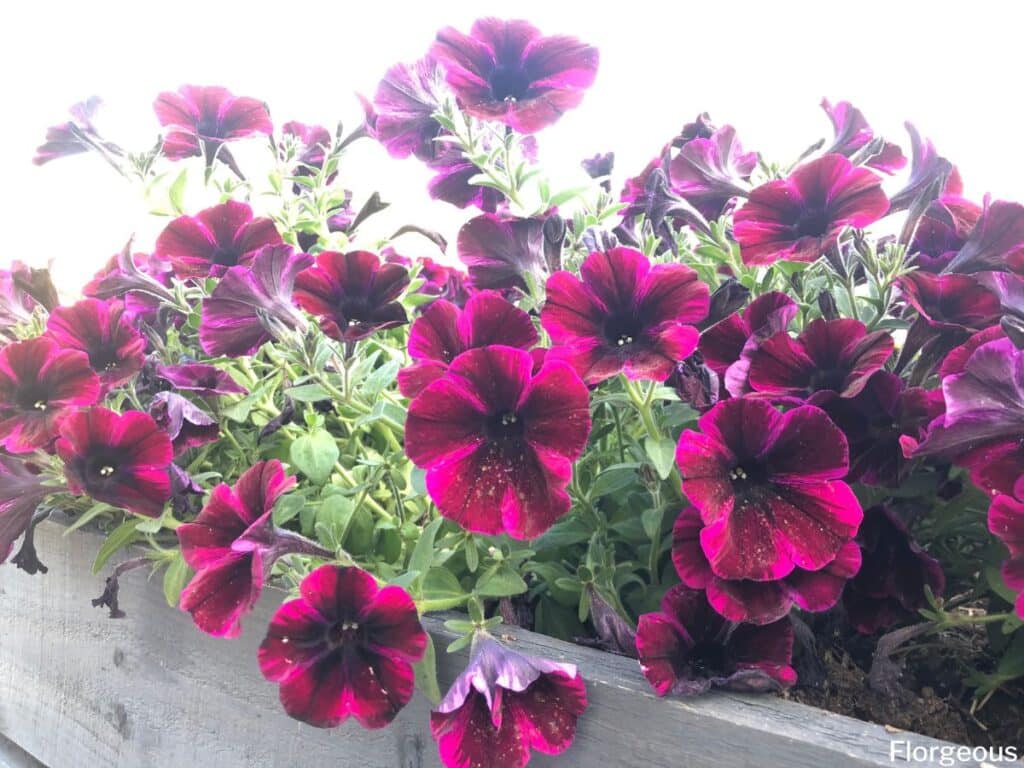
When you are doing petunia companion planting, you should be careful to avoid plant varieties that do not tolerate the same growing area as petunias. Here is a quick look at some of the plant varieties to avoid in your garden bed or hanging baskets.
Shade Loving Plants
Shade-loving plants like hostas, begonias, and ferns won’t grow well in the same hot and sunny areas as petunias. These plants will quickly dry out and die if they are exposed to too much sunlight.
Moisture Loving Plants
Petunias can tolerate a little bit of moisture but they grow their absolute best in dryer conditions. Moisture-loving plants that cannot tolerate dry regions will quickly wilt and die if they are established in dry soil and should be avoided because it can increase your garden maintenance significantly if you have to go around and water individual plants in a dry bed.
FAQs
Can you plant begonias and petunias together?
Begonias and petunias can be planted together in the same garden or container, as they have similar growing requirements, such as well-drained soil and partial sunlight. However, it’s essential to consider the specific varieties of each plant and ensure they share similar water and light preferences for optimal coexistence.
How many petunias do you plant together?
The number of petunias to plant together depends on the available space and the desired aesthetic. For containers, you can typically plant multiple petunias, spacing them according to the specific variety’s recommended guidelines, ensuring they have enough room to grow and spread. In garden beds, spacing can vary based on the type and size of petunia plants, but generally, a few inches between plants is common.
Final Thoughts
Petunias are cheerful flowers that can be paired with a huge variety of ornamental plants like snapdragons, red salvia, dusty miller, and creeping jenny. These florals can also be helpful in vegetable gardens and can be grown amongst many vegetable types or even berry plants like blueberry bushes.
We hope that our guide made it a little bit easier to find good companion plants for your petunia garden.
If you love growing petunias, don’t forget to learn more about petunia flower meaning and why gardeners love them.
Up next:

